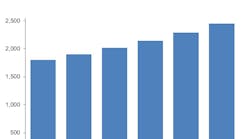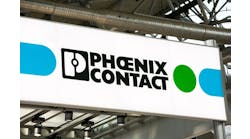The worldwide Coriolis flowmeter market totaled $1.8 billion in 2022 and is projected to grow at an almost 6% compound annual growth rate (CAGR), reaching reach $2.4 billion by 2027, according to a new study, “The world market for Coriolis flowmeters, 7th edition," by Flow Research. Released on Aug. 25, the study reports the Coriolis market is one of the fastest growing flowmeter markets and the largest in terms of revenue.
Known for their high accuracy and reliability in liquids, Coriolis flowmeters are a mainstay in custody transfers of petroleum liquids. Flow Research reports this is why growth remains strong in upstream, midstream and downstream applications, as well as in liquefied natural gas (LNG). Improvements in Coriolis technology mean its flowmeters can measure gases more easily, and they’re why most Coriolis suppliers now offer meters that measure gas flow. The study adds that custody transfer of natural gas is a rapidly growing market for Coriolis meters, especially with the increased popularity of natural gas as an energy source. However, it predicts the fastest-growing gas application in the future will be hydrogen dispensing. Several manufacturers are already offering high-pressure meters capable of measuring hydrogen.
“Suppliers are investing heavily in Coriolis research, and this steady improvement is expanding the number of applications suited for Coriolis meters across various industries,” says Dr. Jesse Yoder, president of Flow Research. “We think one of the most exciting growth areas is hydrogen, which spans both traditional and renewable applications, and is pivotal in the current transition to sustainable energy solutions.”
Coriolis technology keeps improving
Flow Research’s study found that technical improvements for Coriolis meters include higher ranges for flowrates, pressure and temperature. Other enhancements include using titanium and other construction materials that make the flowmeters stronger and longer lasting, as well as specialty flowtubes to accommodate specific applications.
In addition, some flowmeters can now measure volumetric flow, density, temperature, concentration and other variables in addition to mass flow. Many Coriolis manufacturers are also incorporating self-diagnostics and integrated automation, measurement, and digital solutions, including various forms of wireless and wired connectivity to enhance measurement accuracy.
Although most Coriolis flowmeters are still sold for line sizes below 2 in., some companies have introduced Coriolis flowmeters for line sizes above 6 in. Meanwhile, some manufacturers supply meters for line sizes as large as 16 in., primarily for the oil and gas industry. Some industry experts believe that it is only a matter of time until even larger Coriolis meters are built.
In general, Coriolis meters, the most accurate flowmeters on the market, are also the highest priced. Some manufacturers offer lower-cost, lower-accuracy Coriolis meters to increase market penetration. Though these lower-cost meters represent a significant breakthrough, many users are still willing to pay more for Coriolis meters’ accuracy, which is up to ±0.05% for liquids and ±0.25% for gases. Many users also distinguish between purchase cost and cost of ownership, and believe Coriolis meters offer lifecycle savings due to lower maintenance costs. Unlike turbine and positive displacement meters, for example, Coriolis meters don’t have moving parts, apart from the vibrating tube. Plus, their parts aren’t subject to wear similar to orifice plates.





